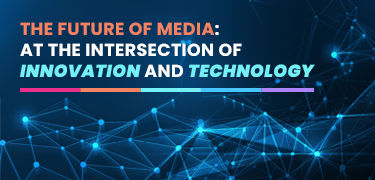The Future of Media: At the Intersection of Innovation and Technology
The media landscape has changed considerably over the last several decades thanks to rapid technical advancements and unique content development and transmission methods. As we approach the dawn of a new era, the convergence of innovation and technology promises to alter how we consume, interact with, and interpret data. This advancement is more than just new gadgets or platforms; it represents a fundamental shift in the foundation of media and communication. The future of media is about producing increasingly personalized, immersive, and interactive experiences that transform our perspective of the world and our place within it, emphasizing the importance of technology in this dynamic progression.


Technological Innovations Shaping Of Future Media
AI and Machine Learning (ML)
AI and machine learning (ML) are altering the media in various ways. AI algorithms make content suggestions more personalized and relevant. Platforms like Netflix and Spotify use AI to analyze user behavior and preferences and deliver customized suggestions that keep audiences interested.
Furthermore, atificial intelligence (AI) is revolutionizing content creation. Automated journalism, which uses AI algorithms to write news stories and reports, is becoming increasingly popular. This technology enables media sources to cover a broader range of topics and post information more quickly, but it raises questions about the legitimacy and trustworthiness of AI-generated news.
VR with Augmented Reality (AR)
VR and AR are set to revolutionize media consumption by providing complete immersion that traditional media cannot replicate. VR can take users to different worlds, resulting in highly engaging gaming, storytelling, and education settings. AR, conversely, superimposes digital information onto the physical environment, improving how we interact with our surroundings.
These media technologies have enormous possibilities beyond entertainment. In journalism, VR may deliver immersive reporting that lets people witness events directly. In education, augmented reality may bring textbooks to life, providing engaging learning experiences that boost understanding and retention.
Blockchain Technology
Blockchain, best known for supporting cryptocurrencies, is making inroads into the media sector. Its decentralized structure offers more transparency and security in content delivery and intellectual property management. By utilizing blockchain, media firms can prevent piracy, provide fair pay for authors, and protect the integrity of their material. For example, smart contracts may automate royalty payments, ensuring authors are adequately compensated and quickly for their work.
Furthermore, blockchain can improve accountability and trust since each transaction and alteration is recorded on an immutable ledger. This media technology also allows new monetization models, such as small transactions and decentralized content platforms, which give artists greater control over their intellectual property and revenue sources.
5G technology
The deployment of 5G networks is expected to transform media consumption by enabling more efficient and trustworthy internet connections. It will improve the quality of streaming services, allow for real-time interactive experiences, and help the expansion of IoT (Internet of Things) devices, which can enable new media consumption contexts like smart homes and linked automobiles.
The Societal Impact of Media Evolution
Enhanced Accessibility and Inclusion
Technological improvements are increasing media accessibility. AI-powered technologies can generate subtitles and translations, while VR and AR can offer experiences to those with impairments. This openness allows a greater audience to participate in media material, promoting diversity and representation.
Ethical Concerns and Misinformation
The emergence of AI and fake information technologies raises ethical concerns, particularly those involving disinformation and digital manipulation. Media businesses must create comprehensive verification systems and promote digital literacy among audiences to counteract the spread of misleading information.
Economic implications.
The shifting media landscape is altering economic structures. Dwindling traditional advertising income pushes media firms to consider new revenue streams such as subscription services, small transactions, and direct fan support via platforms like Patreon.
Conclusion
The future of media, at the confluence of innovation and technology, is more interactive, personalized, and immersive. To thrive in an ever-changing market, media companies must adapt to new consumption patterns and deal with ethical challenges. Using these technologies, the media industry may create more wealthy, interactive experiences that appeal to a broader spectrum of customers globally.


CATEGORIES
- MBA Program
- Data Science and Analytics
- Cloud Computing
- Data Analytics and Business Intelligence
- AI and Digital Systems
- Cyber Security and Digital Forensics
- Business Analytics & Intelligence
- Banking & Financial Services
- International Business
- Digital Marketing
- Research Paper
- Media & Entertainment
- Media Management
- Journalism and Media Production
- Media & Information Technology
- Visual Communication
- Game Development
- Sound Engineering
- Game Art & Design
- Photography
- Film Making
- Animation & VFX
Are you aspiring to become a proficient Media & Information Technology professional?
Look no further; we are committed to nurturing the potential of young minds. Are you ready to enhance your skills?


